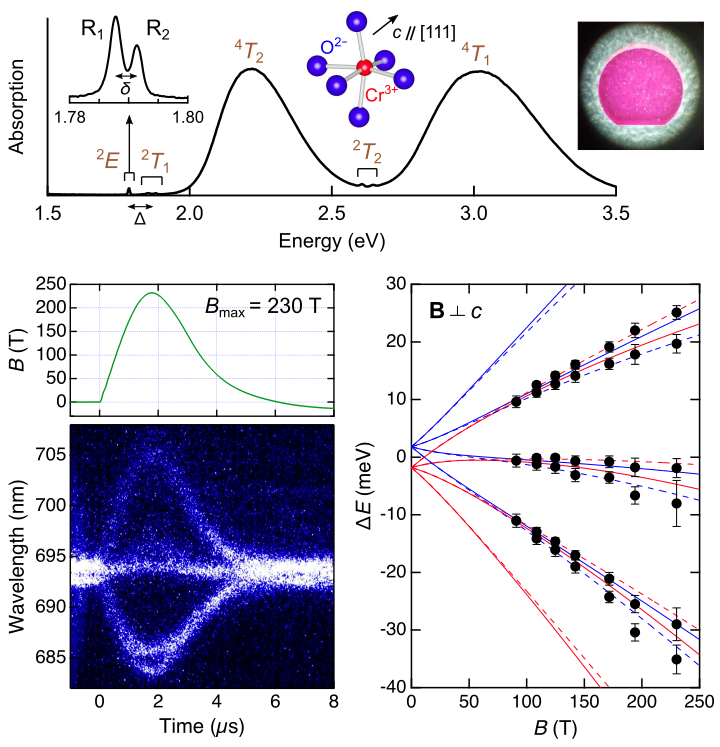Paschen-Back effect in the photoluminescence spectrum of ruby in ultrahigh magnetic fields
Ruby, a familiar gemstone, consists of alumina (Al2O3) containing a small amount of Cr3+ ions. Its absorption spectrum features sharp peaks known as the R lines near a wavelength of 694 nm (corresponding to an energy of 1.79 eV). Owing to this characteristic, ruby has long been a focus of spectroscopic studies, contributing significantly to the development of ligand-field theory and to applications in solid-state lasers.
The R lines correspond to a spin-forbidden transition from the two excited doublets 2E, slightly split by spin–orbit coupling and a trigonal crystal field, to the ground quartet 4A2. The application of a magnetic field on ruby leads to an anomalous Zeeman effect arising from hybridization between the two excited levels, and at higher fields of around 60 T, the split peaks approach a linear-field dependence in the Paschen–Back regime. In this study, we observed the Zeeman splitting of the R lines by means of optical photoluminescence measurements up to 230 T and discovered a novel nonlinear field dependence above 100 T [A]. This behavior can be explained by increasing hybridization of the second excited state 2T1 with the 2E states, which restores orbital degrees of freedom that are otherwise quenched in the 2E level. As this process reorganizes the good quantum numbers of the energy levels, our observation can be regarded as a precursor to the “crystal-field Paschen–Back effect”.
The R lines correspond to a spin-forbidden transition from the two excited doublets 2E, slightly split by spin–orbit coupling and a trigonal crystal field, to the ground quartet 4A2. The application of a magnetic field on ruby leads to an anomalous Zeeman effect arising from hybridization between the two excited levels, and at higher fields of around 60 T, the split peaks approach a linear-field dependence in the Paschen–Back regime. In this study, we observed the Zeeman splitting of the R lines by means of optical photoluminescence measurements up to 230 T and discovered a novel nonlinear field dependence above 100 T [A]. This behavior can be explained by increasing hybridization of the second excited state 2T1 with the 2E states, which restores orbital degrees of freedom that are otherwise quenched in the 2E level. As this process reorganizes the good quantum numbers of the energy levels, our observation can be regarded as a precursor to the “crystal-field Paschen–Back effect”.
References
[A] M. Gen et al., Phys. Rev. Research 2, 033257 (2020). (Original paper[4])
